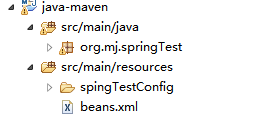BeanFactory有很多实现类,通常使用 org.springframework.beans.factory.xml.XmlBeanFactory类。但对于大部分J2EE应用而言,推荐使 用ApplicationContext. ApplicationContext是
BeanFactory的子接口,其常用实现类是
org.springframework.context.support.FileSystemXmlApplicationContext和
org.springframework.context.support.ClassXmlAplicationContext。
Springr的配置信息通常采用XML配置文件来设置,因此,创建BeanFactory实例时,应该提供XML配置文件作为参数。
方法一:使用FileSystemXmlApplicationContext
代码:
ApplicationContext ac = new FileSystemXmlApplicationContext("classpath:beans.xml"); ac.getBean("beanId");
beans.xml所在位置:如图
1.默认为项目工作路径 即项目的根目录
ApplicationContext appCt2 = new FileSystemXmlApplicationContext("src/main/resources/beans.xml");
2.前缀classpath:表示的是项目的classpath下相对路径
ApplicationContext appCt2 = new FileSystemXmlApplicationContext("classpath:beans.xml");
3.使用前缀file 表示的是文件的绝对路径
ApplicationContext appCt2 = new FileSystemXmlApplicationContext("file:E:/workspace/java-maven/src/main/resources/beans.xml");
ApplicationContext appCt2 = new FileSystemXmlApplicationContext("E:/workspace/java-maven/src/main/resources/beans.xml");
4.可以同时加载多个文件
String[] xmlCfg = new String[] { "src/main/resources/base.spring.xml","classpath:app.spring.xml"};
ApplicationContext appCt2 = new FileSystemXmlApplicationContext(xmlCfg);
5.使用通配符加载所有符合要求的文件
ApplicationContext appCt2 = new FileSystemXmlApplicationContext("classpath:*.spring.xml");
说明:
这种方式适用于采用Spring框架的独立应用程序,需要程序通过配置文件手工初始化Spring的情况。
方法二:使用ClassPathXmlApplicationContext
可以从classpath中读取XML文件
(1)没有前缀:默认为项目的classpath下相对路径
ApplicationContext context = new ClassPathXmlApplicationContext("beans.xml");
(2).前缀classpath:表示的是项目的classpath下相对路径
ApplicationContext appCt = new ClassPathXmlApplicationContext("classpath:app.spring.xml");
(3)使用前缀file 表示的是文件的绝对路径
ApplicationContext appCt = new ClassPathXmlApplicationContext("file:E:/workspace/java-maven/src/main/resources/beans.xml");
(4)可以同时加载多个文件
String[] xmlCfg = new String[] { "classpath:beans.xml","spring-context.xml"};
ApplicationContext appCt = new ClassPathXmlApplicationContext(xmlCfg);
(5).使用通配符加载所有符合要求的文件
ApplicationContext appCt = new ClassPathXmlApplicationContext("*.spring.xml");
方法三:通过Spring提供的工具类获取ApplicationContext对象
代码:
import org.springframework.web.context.support.WebApplicationContextUtils; ApplicationContext ac1 = WebApplicationContextUtils.getRequiredWebApplicationContext(ServletContext sc) ApplicationContext ac2 = WebApplicationContextUtils.getWebApplicationContext(ServletContext sc) ac1.getBean("beanId"); ac2.getBean("beanId");
说明:
这种方式适合于采用Spring框架的B/S系统,通过ServletContext对象获取ApplicationContext对象,然后在通过它获取需要的类实例。
上面两个工具方式的区别是,前者在获取失败时抛出异常,后者返回null。
方法四:继承自抽象类ApplicationObjectSupport
说明:
抽象类
ApplicationObjectSupport提供getApplicationContext()方法,可以方便的获取到
ApplicationContext。Spring初始化时,会通过该抽象类的
setApplicationContext(ApplicationContext context)方法将ApplicationContext
对象注入。
方法五:继承自抽象类WebApplicationObjectSupport
说明:
类似上面方法,调用getWebApplicationContext()获取WebApplicationContext
方法六:实现接口ApplicationContextAware
说明:
实现该接口的setApplicationContext(ApplicationContext context)方法,并保存ApplicationContext 对象。Spring初始化时,会通过该方法将ApplicationContext 对象注入。
以上方法适合不同的情况,请根据具体情况选用相应的方法。
这里值得提一点的是,系统中用到上述方法的类实际上就于Spring框架紧密耦合在一起了,因为这些类是知道它们是运行在Spring框架上的,因此,系统中,应该尽量的减少这类应用,使系统尽可能的独立于当前运行环境,尽量通过DI的方式获取需要的服务提供者。
本人认为,方法六比较可行,可以设计一个工具类,专门来获取Spring中的类。减少对业务代码的侵入性。
读取xml文件
/** * 利用XmlBeanFactory(Resource resource) * 这里Resource必须是xml格式 * Resource包括:AbstractResource, ClassPathResource, FileSystemResource, * InputStreamResource, ServletContextResource, UrlResource */ /* * 利用 InputStreamResource(InputStream inputStream) * 要将applicationContext.xml放在项目根目录下 */ InputStream is = null; try { is = new FileInputStream("applicationContext.xml"); } catch (FileNotFoundException e) { e.printStackTrace(); } Resource resource = new InputStreamResource(is); BeanFactory factory = new XmlBeanFactory(resource); UserDao userDao = (UserDao)factory.getBean("userDao");
/*
* 利用 Properties
* 要将bean.properties放在类路径--源文件夹(src)目录下
*/
这里介绍两种技术:利用spring读取properties 文件和利用java.util.Properties读取
(一)利用spring读取properties 文件
利用org.springframework.beans.factory.support.PropertiesBeanDefinitionReader来读取属性文件
构造如下config.properties文件properties代码
userDao.class=com.spring.dao.UserDao
属性文件中的"userDao"名称即是Bean的别名设定,.class用于指定类来源。
然后利用org.springframework.beans.factory.support.PropertiesBeanDefinitionReader来读取属性文件
BeanDefinitionRegistry reg = new DefaultListableBeanFactory(); PropertiesBeanDefinitionReader reader = new PropertiesBeanDefinitionReader(reg); reader.loadBeanDefinitions(new ClassPathResource("config.properties")); BeanFactory factory = (BeanFactory)reg; UserDao userDao = (UserDao)factory.getBean("userDao");
(二)利用java.util.Properties读取属性文件
1.
String str=File.separator; InputStream path=this.getServletContext().getResourceAsStream(str+"WEB-INF"+str+"classes"+str+"password.properties"); //InputStream inputStream = this.getClass().getClassLoader().getResourceAsStream("password.properties"); /*File filepath=new File(this.getServletContext().getRealPath(str+"WEB-INF"+str+"classes")+str+"password.properties"); InputStream path=new FileInputStream(filepath);*/ Properties pros = new Properties(); try { pros.load(path); } catch (IOException ex) { //System.out.println("file is not exist"); errorMessage="资源文件不存在"; } System.out.println("username:"+p.getProperty("username")+",password:"+p.getProperty("password"));
2.
import org.springframework.core.io.ClassPathResource; ClassPathResource cr = new ClassPathResource("password.properties");//会重新加载spring框架 Properties pros = new Properties(); try { pros.load(cr.getInputStream()); } catch (IOException ex) { //System.out.println("file is not exist"); errorMessage="资源文件不存在"; }
2. 利用ClassPathResource
可以从classpath中读取XML文件
Resource cr = new ClassPathResource("applicationContext.xml"); BeanFactory bf=new XmlBeanFactory(cr); UserDao userDao = (UserDao)bf.getBean("userDao");
加载一个xml文件org.springframework.beans.factory.config.PropertyPlaceholderConfigurer不起作用
3.利用XmlWebApplicationContext读取
从Web应用程序的文件架构中,指定相对位置来读取定义文件。
XmlWebApplicationContext
的建構子無法帶參數,參考API文件會發現,預設的location會指向/WEB-INF/applicationContext.xml檔案。使用其
public
static屬性DEFAULT_CONFIG_LOCATION可取得此預設檔名。由於我使用MyEclipse,預設會多一個"/WebRoot"的
目錄在WEB-INF之前,因此若在web
project裡有一些與web無關的程式要使用context時(例如處理一些MVC架構中的"M"的部份),就無法使用
XmlWebApplicationContext來讀取bean定義檔,因為default location會差一個"WebRoot"的目錄。
即
使在web.xml裡面,在DispatcherServlet定義中重新定義contextConfigLocation也一樣(此定義可以
override掉XmlWebApplicationContext中的DEFAULT_CONFIG_LOCATION值),因為與web無關的程式
並不會經過web.xml的定義檔設定。目前我還沒試成功過XmlWebApplicationContext取得bean定義檔,使用
ClassPathXmlApplicationContext反而會快一些。
XmlWebApplicationContext ctx = new XmlWebApplicationContext(); ctx.setConfigLocations(new String[] {"/WEB-INF/ applicationContext.xml"); ctx.setServletContext(pageContext.getServletContext()); ctx.refresh(); UserDao userDao = (UserDao ) ctx.getBean("userDao ");
4.利用FileSystemResource读取
Resource rs = new FileSystemResource("D:/tomcat/webapps/test/WEB-INF/classes/ applicationContext.xml"); BeanFactory factory = new XmlBeanFactory(rs); UserDao userDao = (UserDao )factory.getBean("userDao");
值得注意的是:利用FileSystemResource,则配置文件必须放在project直接目录下,或者写明绝对路径,否则就会抛出找不到文件的异常